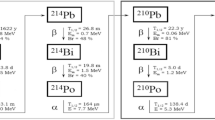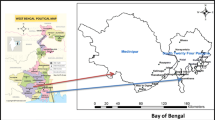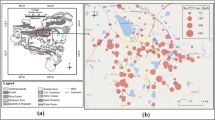Abstract
Radon activity concentrations have been measured by analysing a total of 93 bore well water samples, geographically spread over three taluks of Yadagir district. The analysis involved usage of Durridge’s RAD7 radon analyser equipment with RAD-H2O accessories by closed loop aeration concept. Having geometric mean concentrations of 37.0, 20.75 and 9.98 Bq/L, radon concentration in 5.71, 14.29 and 6.67% groundwater samples from Yadagir (8.88 Bq/L < Rn < 160 Bq/L), Shahapur (1.98 Bq/L < Rn < 591 Bq/L) and Surpur (0.586 Bq/L < Rn < 206 Bq/L) taluks respectively exceeded the alternative maximum contaminant level (AMCL) of the USEPA (148 Bq/L). Nearly 15% of the groundwater samples had radon concentrations higher than WHO reference level of 100 Bq/L. The calculated total annual effective dose in 38.71, 44.09, and 55.92% of the samples respectively for infants, children and adults was not in consistent with WHO recommended dose level of 100 µSv/y.




Similar content being viewed by others
References
Badhan K, Mehra R, Sonkawade RG (2010) Measurement of radon concentration in groundwater using RAD7 and assessment of average annual dose in the environs of NITJ, Punjab, India. Indian J Pure Appl Phys 48:508–511
Kumar A, Kaur M, Sharma S, Mehra RA (2016) Study of radon concentration in drinking water samples of Amritsar city of Punjab (India). Radiat Prot Environ 39:13–19
Moreno V, Bach J, Baixeras C, Font L (2014) Radon levels in groundwaters and natural radioactivity in soils of the volcanic region of La Garrotxa. Spain J Environ Radioact 128:1–8
Fonollosa E, Penalver A, Borrull F, Aguilar C (2016) Radon in spring waters in the south of Catalonia. J Environ Radioact 151(1):275–281
Knutsson G, Olofsson B (2002) Radon content in groundwater from drilled wells in the Stockholm region of Sweden. Norg Geol Under Bull 439:79–85
Asikainen M, Kahlos H (1979) Anomalously high concentration of uranium, radium and radon in water from drilled wells in the Helsinki region. Geochim Cosmochim Acta 43:1681–1686
Lahermo P, Juntunen R (1991) Radiogenic elements in Finnish soils and groundwaters. Appl Geochem 6:169–183
Frengstad B, Midtgard AK, Banks D, Krog RK, Siewers U (2000) The chemistry of Norwegian groundwater III. The distribution of trace elements in 476 crystalline bedrock groundwaters, as analyzed by ICP-MS techniques. Sci Total Environ 246:21–40
Jobbágy V, Altzitzoglou T, Malo P, Tanner V, Hult M (2017) A brief overview on radon measurements in drinking water. J Environ Radio 173:18–24
Srinivasa E, Rangaswamy DR, Suresh S, Nagabhushana SR, Sannappa J, Umehsareddy K (2018) Measurement of radon concentration in drinking water and estimation of radiation dose to the public of Hassan city, Karnataka. India Radiat Prot Environ 41:132–135
Chaki A, Purohit RK, Mamallan R (2011) Low grade uranium deposits of India—a bane or boon. Energy Procedia 7:153–157
Manoj S, Thirumurugan M, Elango L (2017) An integrated approach for assessment of groundwater quality in and around Uranium mineralised zone, Gogi region, Karnataka, India. Arab J Geosci 10:557
CGWB (2012) Central Ground Water Board – ground water information booklet of Yadagir District, Karnataka, South Western Region, Ministry of Water Resources, Government of India, pp25
Durridge Company Inc., (2015) RAD7 Radon Detector, User manual revision 7.4.0. Retrieved on March,10th, 2016 from. (http://www.durridge.com/products_ rad7.shtml)
Ravikumar P, Somashekar RK (2018) Distribution of 222Rn in groundwater and estimation of resulting radiation dose to different age groups: a case study from Bangalore City. Hum Ecol Risk Assess Int J 24(1):174–185
Ravikumar P, Somashekar RK (2014) Determination of the radiation dose due to radon ingestion and inhalation. Int J Environ Sci Technol 11:493–508. https://doi.org/10.1007/s13762-013-0252-x
USEPA (1999) Radon in drinking water: health risk reduction and cost analysis. Federal Register 64, Washington
USEPA (2009) U.S. environmental protection agency. National primary drinking water regulations. Washington, DC: EPA; 2009 [cited 2011 Mar 29]. (http://water.epa.gov/drink/contaminants/index.cfm#List)
USEPA (2011) U.S. Environmental protection agency. Proposed radon in drinking water regulation. Washington, DC: EPA; 2011 [cited 2011 Mar 29]; (http://water.epa.gov/lawsregs/rulesregs/sdwa/radon/regulations.cfm)
WHO (2008) World Health Organization - guidelines for drinking-water quality, Vol. 1. Recommendations, third ed., Geneva
Euratom (2013) Euratom Council Directive 2013/51/Euratom of 22 October 2013 Laying down requirements for the protection of the health of the general public with regard to radioactive substances in water intended for human consumption
UNSCEAR (2000) United Nations scientific committee on the effects of atomic radiations, sources, effects and risks of ionising radiation. United Nations, New York, p 2000
WHO (1998) World Health Organization - guidelines for drinking water quality, vol. 1. Geneva Publication, p.202
UN, (2008) United nations report to general assembly with scientific annexes. United Nations Sales Publications, United Nations, New York, Scientific Committee on the Effect of Atomic Radiations
NRC (1999) National research council, committee on health risks of exposure to radon, health effects of exposure to Radon, BEIR series, No. National Academies Press, VI (Washington, D.C., p 1999
UNSCEAR (2019) Report of the United Nations scientific committee on the effects of atomic radiation. Seventy-fourth Session (Sixty-sixth session, 10–14 June 2019), Supplement No. 46. United Nations, New York, pp 13–17
ICRP (2018) International commission on radiological protection - summary of ICRP recommendations on Radon. ICRP ref. 4836–9756–8598, pp.5–6
Harrison JD, Marsh JW (2020) ICRP recommendations on radon. Annals of the ICRP, 49(1_suppl), 68–76. https://doi.org/10.1177/0146645320931974
Cho BW, Choo CO (2019) Geochemical behavior of uranium and radon in groundwater of Jurassic Granite Area, Icheon. Middle Korea Water 11:1278
Pereira AJSC, Pereira MD, Neves LJPF, Azevedo JMM, Campos ABA (2015) Evaluation of groundwater quality based on radiological and hydrochemical data from two uraniferous regions of Western Iberia: Nisa (Portugal) and Ciudad Rodrigo (Spain). Environ Earth Sci 73:2717–2731
Idriss H, Salih I, Sam AK (2011) Study of radon in ground water and physicochemical parameters in Khartoum state. J Radioanal Nucl Chem 290(2):333–338
Skeppström K, Olofsson B (2006) A prediction method for radon in groundwater using GIS and multivariate statistics. Sci Total Environ 367:666–680
Wallner G, Steininger G (2007) Radium isotopes and 222Rn in Austrian drinking waters. J Radioanal Nucl Chem 274:511–516
Beyermann M, Bünger T, Schmidt K, Obrikat D (2010) Occurrence of natural radioactivity in public water supplies in Germany: 238U, 234U, 235U, 228Ra, 226Ra, 222Rn, 210Pb, 210Po and gross alpha activity. Radiat Prot Dosim 141:72–81
Cantaluppi C, Fasson A, Ceccotto F, Cianchi A, Degetto S (2014) Radionuclides concentration in water and mud of euganean thermal district. Int J Environ Res 8:237–248
Somlai K, Tokonami S, Ishikawa T, Vancsura P, Gaspar M, Jobbagy V, Somlai J, Kovacs T (2007) Rn-222 concentrations of water in the Balaton Highland and in the southern part of Hungary, and the assessment of the resulting dose. Radiat Meas 42:491–495
Cho BW, Hwang JH, Lee BD, Oh YH, Choo CO (2020) Radon concentrations in raw water and treated water used for bottled water in South Korea. Sustainability 12(13):5313
Dueñas C, Fernández MC, Carretero J, Liger E, Cañete S (1999) 226Ra and 222Rn concentrations and doses in bottled waters in Spain. J Environ Radioact 45:283–290
WHO (2004) World Health Organization guidelines for drinking water quality (Vol. 1, 3rd ed.). Geneva
Acknowledgements
Authors are thankful to the Board of Research in Nuclear Sciences (BRNS), Bhabha Atomic Research Centre (BARC), Government of India, Mumbai as the radon analysis would have not been possible without their financial assistance to procure RAD7 radon analyser.
Author information
Authors and Affiliations
Corresponding author
Additional information
Publisher's Note
Springer Nature remains neutral with regard to jurisdictional claims in published maps and institutional affiliations.
Rights and permissions
About this article
Cite this article
Ravikumar, P., Naika, K., Prakash, K.L. et al. Quantification of radon concentration in groundwater around abandoned Gogi uranium mineralized zone, Yadagir district, Karnataka, India. J Radioanal Nucl Chem 329, 489–498 (2021). https://doi.org/10.1007/s10967-021-07814-9
Received:
Accepted:
Published:
Issue Date:
DOI: https://doi.org/10.1007/s10967-021-07814-9




